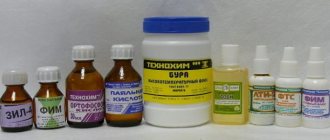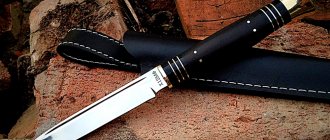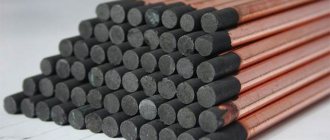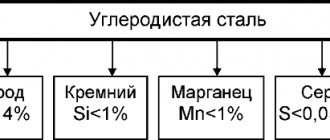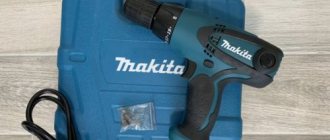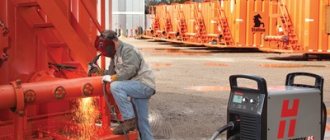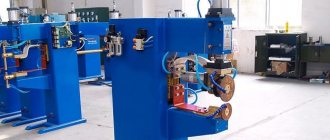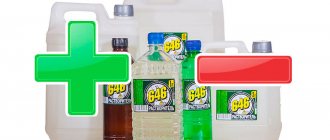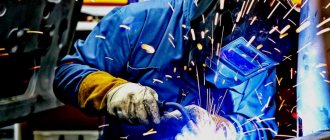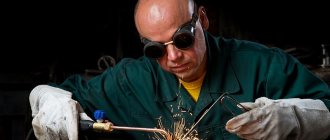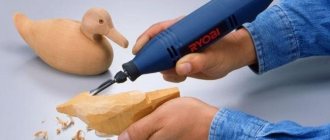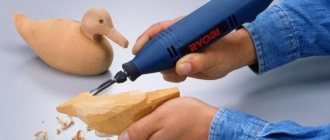To improve the quality of the seam, increase the efficiency of equipment, and reduce production costs, welding flux is used. What is it, what form does welding flux come in, how is it classified and used - we’ll look at this in the article.
Welding flux is a substance supplied in advance to the welding zone or directly when applying a seam. It can be a powder with granules from 0.25 to 4 mm or a paste. Some fluxes are initially supplied in bulk form but are mixed with ethanol to create a creamy consistency before use. There is a welding wire for semi-automatic machines with a hollow structure in the form of a tube, which contains flux inside. This type of wire is called flux cored wire. There is a self-protecting one (no gas needed) and for welding with gas.
When exposed to the temperature of the welding arc, the flux melts, releasing dense gas. It protects the molten metal from the external environment. The low density of the granules ensures instant melting even before the metal has become liquid, so by the time the weld pool is formed, a reliable isolated environment is formed. In addition to its protective functions, flux has other advantages, which are discussed below.
Why do you need flux when welding?
The use of fluxes provides the following advantages in welding.
- In both electric arc and gas welding, the welding flux provides more intense melting of the metal (at high currents or high oxygen concentrations, respectively). Thanks to this, there is no need to cut the edges of the future weld in advance.
- In the weld area and on the surfaces adjacent to it, it is possible to avoid metal waste - its losses due to oxidation and evaporation .
- Arc burning has higher stability , which is especially important for complex seam configurations
- Energy losses of the current source for heating the metal are reduced, and its efficiency increases accordingly.
- The consumption of filler material is optimized .
- More convenient work for the welder, because the flux shields some of the arc flame.
Application for various metals
Phosphoric and soldering acids are used for soldering parts made of stainless and alloy steel. Borax is used for soldering cast iron, precious metals, and nickel-cobalt alloys. Borax is often used in the repair of plumbing systems. Soldering fat is used when soldering lead couplings to the lead sheath of a cable. It consists of rosin, animal fat and stearin.
Flux brand FPPU25 is used for tinning and soldering of current-carrying parts made of copper and its alloys. For soldering ferrous metals, the active auxiliary material zinc chloride is used.
If you don’t have ready-made flux on hand, you can use a solution of aspirin tablets in cologne, fruit juice or olive oil instead.
To create a strong solder joint, you need a good soldering iron with a properly selected tip, as well as solder and flux that are suitable for this type of work. Only if these conditions are met can the required connection quality be ensured.
Conditions for using welding fluxes
The purpose of the flux is to stabilize metallurgical processes while maintaining the required productivity of the electrodes. To do this, certain conditions must be observed during the welding process.
- The flux should not react chemically with the metal of the rod and the base metal.
- The weld pool area must remain isolated throughout the welding process.
Residues of flux associated with the slag crust as a result of welding should be easily removed upon completion of work. Moreover, up to 80% of the material can be reused after cleaning.
Semi-automatic
A protective inert gas (argon or helium) is used and cored wire is used. The gas protects the weld pool at all times, and the powder melts as the electrode burns, forming additional insulation. At the same time, energy consumption is reduced, the seam is very smooth, practically without scales. After welding is completed, a thin slag crust is present on the surface of the seam, which can be easily removed with a hammer. This is the most expensive welding method because it consumes shielding gas and flux-cored wire. But the connections are of high quality and are suitable for critical structures, for example, for containers in the chemical industry.
Semi-automatic submerged arc welding uses a conventional MIG/MAG machine with direct current. Only the welding wire and rollers are changed. It is important to correctly adjust the pressure in the feed mechanism so that the roller does not press down the hollow wire.
How fluxes work
- Before welding, a thick (40-60 mm) layer of flux is applied to the joints.
- The electrode is inserted into the welding zone and the arc is ignited.
- Under the influence of high temperatures (up to 6000 °C), the flux with its low density quickly melts in a gas bubble, isolating the weld pool from above, blocking access to gas, water vapor and other chemicals.
- Having a high surface tension, in the same way the flux melt prevents intense splashing of the metal.
- This allows you to significantly increase the arc current (up to 1000-2000 Amperes) without serious loss of electrode material and while maintaining good weld quality.
- Under the influence of flux, thermal power is concentrated in the arc zone - as a result, the melting of the metal occurs faster.
- In this case, all joints are filled with metal, regardless of the condition of the edges.
- The material balance of the weld changes - 60-65% of it is the metal of the parts being welded, and only the rest is the metal of the welding electrode.
Requirements for auxiliary materials
There are general requirements that apply to all types of excipients. What basic properties should they have:
- The fluidity and viscosity of the composition must be in such a ratio that it is possible to wet the entire surface to be treated without spreading beyond the processing boundaries.
- Fluxes should react only with oxidized films, and not with the parts being connected and solder.
- Flux should have less adhesion than solder.
- The substance must not evaporate or burn out.
- The flux should be easily removed after completion of work.
How to solder with flux: first you need to prepare the parts, then treat them with the material, then heat the parts to the desired temperature and apply solder to the treated area.
Welding fluxes - classification
The classification of fluxes is extremely broad. They are distinguished by appearance and physical state, chemical composition, method of production, and purpose. So, for example, for surfacing or arc welding, as a rule, granular or powder fluxes with certain electrical conductivity indicators are used, and for gas welding, gases, powders, and pastes are used.
According to the method of obtaining composites
There are fused and unfused fluxes.
Fused welding flux is widely used not only in welding, but also in surfacing. It demonstrates high efficiency in cases where the surface of the weld metal, by adding additional chemical elements, must obtain higher technical characteristics - for example, increased resistance to corrosion or a very even and smooth weld.
Submerged Surfacing
Fused fluxes are obtained in the following way: the components are ground, mixed, then melted in flame or electric furnaces in the complete absence of oxygen. The heated particles are then passed through a continuous stream of water, hardening and thus turning into granulate. The particle size varies - the thinner the welding rod, the smaller the granules should be.
Unmelted fluxes (ceramic) for welding are made by mixing crushed particles of a mixture of ferroalloys, minerals, and slag-forming materials without subsequent melting. The particles are mixed with glass and then sintered.
Among their advantages:
- low consumption,
- possibility of repeated use,
- high quality of the resulting seam.
An example is UF grade ceramic welding flux (UF-01, UF-02, UF-03), which is used in energy and civil engineering for welding metal structures made of high-strength low-alloy steels.
Chemical composition of fluxes for welding
Chemical composition is an important component in the characteristics of fluxes. The material must be chemically inert at very high temperatures. In addition, it must ensure effective diffusion of individual elements (for example, alloying elements) into the weld metal.
The largest mass fraction (from 35...80% of the total volume) in welding flux is usually (but not all) silicon dioxide (silica) - an acidic oxide, a colorless transparent crystalline mineral. Silicon prevents the process of carbon formation , thereby reducing the risk of cracks and pores in the weld metal.
A significant part is manganese . As an active deoxidizer, this component of welding fluxes reduces the formation of oxides in the weld pool area, reacting first with oxygen in iron oxides, then with silicon oxide. The result of a complex reaction is manganese oxide, which is insoluble in steel and subsequently easily removed. In addition, manganese reacts with sulfur, which is harmful to the weld metal—it binds with it to form sulfide, which is then also removed from the surface of the weld.
Also among the chemical elements of fluxes are alloying additives - in addition to silicon and manganese, these are molybdenum, chromium, titanium, tungsten, vanadium and others . The task is to restore the primary chemical composition of the metal, and in some cases, by alloying, to replenish the burnt-out main impurities of the steel and provide the weld metal with additional special properties. Usually in flux they are represented by compounds with iron - ferroalloys (ferrochrome, etc.).
Flux manufacturing technology
During the manufacturing process, the flux base (charge) is subjected to several processing procedures, including smelting, granulation, molding and quality testing. Before the production process, the raw materials of the charge are segmented into small, medium and large. Each batch undergoes thorough washing and drying, since the purity and accuracy of the parameters of the future flux are maintained from the very beginning. Then weighing, dosing and mixing with other technological components are performed. Melting and granulation of flux for welding is carried out using special equipment - gas-flame or electric arc furnaces, pools for pouring cold water and metal trays are used. At the final stages of processing, drying and sifting are performed. The flux that has passed the inspection is packaged in special bags or boxes with fire-resistant properties.
Types of fluxes for welding by purpose
Their choice of chemical composition directly depends on the purpose of welding fluxes.
- For welding low-carbon steels, fluxes with a high content of silicon and manganese are used in combination with low-carbon steel wire without alloying additives. The second option is a small proportion of manganese (or no manganese at all) in the flux, but alloying additives are present in the steel of the welding rod.
- For welding low-alloy steels, fluxes with high chemical inertness are used - higher than for low-carbon steels. This results in a more ductile weld. An example is flux for welding steel AN-46.
- For welding high-alloy metals, fluxes with minimal chemical activity are used. Silicon, like manganese, is practically not used - it is replaced by fluorite (fluorspar), due to which easily separated fusible slags are formed. Also, such fluxes usually contain aluminum oxide and quicklime.
- To weld active metals (such as titanium), salt fluxes are used - as a rule, these are chloride and fluoride salts of alkali metals. The admixture of oxygen is completely absent in them, since it reduces the plasticity of the seam.
Activity
An important characteristic of flux composites is the conventional unit Af - the activity of the welding flux. Its values fall within the range from 1 to 10. The higher the number, the more active the additive is. Fluxes with high activity are characterized by an indicator value from 0.6 to 1.
When flux components interact with slag, chemical displacement of some elements by others, mechanical mixing, or two processes simultaneously occur.
The intensity of flux penetration into the welding zone depends on the welding mode and flux activity. With a skillful combination of parameters and the correct selection of all materials, the task is accomplished.
Purpose of welding flux - examples
| Fused fluxes | Unmelted fluxes | ||
| AN-348-A, AN-348-AM, AN-348-V, AN-348-VM, OSTS-45, OSTS-45M, AN-60, FC-9 | Mechanical welding and surfacing of low-alloy and carbon steels with low-alloy and carbon welding wire | ANK-35 | Welding low-carbon steels with low-carbon wire Sv-08 and Sv-08A |
| AN-8 | Electroslag welding of carbon and low-alloy steels; welding of low-alloy steels with carbon and low-alloy welding wire. | ANK-46 | Welding low-carbon and low-alloy steels |
| AN-15M, AN-18, AN-20S, AN-20P, AN-20SM | Automatic arc welding and surfacing of high- and medium-alloy steels | ANK-30, ANK-47 | Welding seams of high cold resistance |
| AN-22 | Electroslag welding and automatic arc surfacing and welding of low and medium alloy steels | ANK-45 | Welding of high alloy steels |
| AN-26S, AN-26P, AN-26SP | Automatic and semi-automatic welding of stainless, corrosion-resistant and heat-resistant steels | ANK-40, ANK-18, ANK-19 | Surfacing with low-carbon welding wire Sv-08 and Sv-08A; |
| AN-17M, AN-43 and AN-47 | Arc welding and surfacing of carbon, low and medium alloy steels of high and high strength | ANK-3 | As an additive to flux brands AN-348A, OSTS-45, AN-60 to increase the resistance of seams to pore formation |
Electrode tapes
To reduce the share of the base metal in the deposited layer and obtain a smoother deposited surface, welding electrode strips of various designs are used (Table 5...5.7); in this case, the specified composition of the deposited metal can be obtained already in the first layer, and the tolerance for machining will be no more than 1...1.5 mm. Compared to electrode wire, this is a very productive method of surfacing, especially on flat and cylindrical surfaces of large-diameter products.
Table 5. Electrode welding tapes
| Brand | Weld metal type | Operating conditions of welded parts, properties of weld metal |
| Sv-2X13 | 20Х12 | Metal-to-metal friction at temperatures up to 450 °C and the presence of an aggressive environment (pipeline fittings). After surfacing HRC 45…46, after tempering HRC 28…34 |
| Sv-04Х19Н11М3 | 4Х18Н10М2Г1 | Corrosive wear. Surfacing of the second layer on pearlitic steel, if the structure is not subjected to heat treatment in the temperature range of 500...800 °C. Welded metal stands against MCC |
| Sv-03Х22Н11Б (EP-799) | 3Х20Н9Б | Corrosive wear. For single-layer surfacing and application of the first layer during double-layer surfacing on parts made of pearlitic steel. Welded metal stands against MCC |
| Sv-10X16N25AM6 | 9Н22Х14М5AG1 | Corrosive wear. Surfacing of the first layer during two- or three-layer surfacing on parts made of pearlitic steels. Welded metal stands against MCC |
| Sv-07Х25Н13 | 8Х23Н12Г1 | Corrosive wear. Single-layer surfacing of parts, if the structure is not thermally treated in the temperature range 500...800 °C and application of the first layer in double-layer surfacing on parts made of pearlitic steels |
| Sv-03Х15Н35Г7М6Б | 2Н34Х14Г6М6Б1 | Corrosive wear. Single-layer surfacing on parts made of heat-resistant pearlitic steels and steels of type 18-8, if the products are not thermally treated. Welded metal stands against MCC |
Note. 1. Size of electrode tapes: 50×0.7; 65×0.7; 100×0.7 mm.
2. Material consumption coefficient - 1.05.
Table 6. Powder electrode tapes
| Brand and size | Weld metal type | Flux brand | Operating conditions of the deposited metal and its properties |
| PL-U25Х25Г3Ф2Р 45×3 | 250X25G3F1N1RS | AN-20 AN-15M | Abrasive wear with moderate impacts (working parts of earth-moving machines) HRC-54 |
| PL-U30Х30Г3ТУ 45×1 | 300Х30Г3ТУ | AN-60 | Same. HRC ≥ 47 |
| PL-AN171 20×4 | 100Х20Г4С3Ф2 | AN-15M | Intense gas and water abrasive wear (hulls and impellers of dredgers, working parts of earth-moving machines) HRC 50…65 |
| PL-AN111 14×4 | 550X44N34GSR | AN-20 AN-15 | Abrasive wear with moderate impacts at elevated temperatures up to 600 °C (contact surfaces of blast furnace charging devices, grates) |
| PL-U40X38G3RTYU 45×3 | 400X38GZRT | AH-60 | Intense abrasive wear without impacts (clay mixer blades, parts of earthmoving machines) HRC 50…54 |
| PL-AN150 20×4 | 9Х18Н9С5Г2Т | AH-26 AH-15M | Metal-to-metal friction under conditions of corrosion and cavitation erosion at normal and elevated temperatures up to 540° (Parts of large oil and energy fittings) HRC 28…34 |
Note. Material consumption coefficient 1.05…1.15.
Table 7. Electrode strips sintered according to GOST 22366-93
| Tape brand | Weld metal type | Flux brand | Operating conditions of welded parts, properties of weld metal |
| LS-5Х4В3FS | 50Х4В3ФСГ | AN-60 | Thermal fatigue, heavy loads and moderate abrasive wear (hot rolls, hot metal cutting knives, hot stamping dies) HRC 38…44 |
| LS-5ХВ2М2ФС | 50Х4В2М1Г | AN-60 | Same. HRC 45…48 |
| LS-70Х3НМ(A) LS-70Х3НМ(B) | 70Х3ГСНМ | AN-60 AN20P AN26P | Intense abrasive wear and moderate loads at normal and elevated temperatures up to 300°C. A - for single-layer, B - for multi-layer surfacing (chassis of trucks and tractors, spring supports, parts of automatic coupling of cars, rollers of roller conveyors, road wheels). HRC 52…58 |
| LS-U10H7GR1 | 100Х7ГР | AN-60 | Intense abrasive wear with moderate impacts (wheels and rollers of tracked vehicles, blades of bulldozers and graders). HRC 56…58 |
| LS-1Х14Н3 | 12X14H3 | AN20P AN26P | Abrasive wear and corrosion at normal and elevated temperatures up to 450° (hydraulic press plungers, ship shafts). HRC 47…49 |
| LS-20Х10Г10Т | 20Х10Г10Т | AN20P AN26P | Friction and corrosion (pistons of hydraulic presses, crane wheels, parts of automatic coupling devices) HB 220…240, after hardening HB 450…520 |
| LS-08Х21Н9Г | 6Х21Н9Г | AN26P | Corrosive wear (flanges, pipes and vessels of power and petrochemical equipment), deposited metal is prone to MCC |
Note. 1. Tape sizes: 30×0.8…1.2, 60×0.8…1.2; 80×0.8…1.2 mm.
2. Material consumption coefficient - 1.05.
Fluxes for gas welding
For welding aluminum and other non-ferrous metals, cast iron, tool steels, and certain grades of thin sheet steel, a protective gas atmosphere is used. It is provided by gaseous, paste, and powder fluxes. They can be applied:
- on the edges of the parts being connected;
- directly into the weld pool;
- to the filler rod.
Depending on the physical state of the material, fluxes for welding are supplied to the work area in different ways. Powdered composites cause some difficulty - they must be evenly and accurately introduced into the melt, without allowing the gas flow to blow up the powder. The compositions in the form of pastes are fed to the connection area. To supply gaseous fluxes, flow meters are used - with their help, gas is dosed into the working area.
Electromagnetic flow meter
An important point: for gas welding, the composition of the flux is selected depending on the oxides formed during welding. If they are acidic, the fluxes must be alkaline (basic); on the contrary, if they are alkaline oxides, acidic fluxes should be chosen.
The fluxes most widely used in gas welding are:
- copper, brass, bronze - for welding they use acidic fluxes containing boron-containing compounds (boric acid, etc.) - for example, brands such as MB-2 or BM-1;
- cast iron - for its welding, fluxes containing various compounds of alkali metals - sodium and potassium - are usually used;
- aluminum - compositions containing potassium, lithium and sodium fluorides, as well as chlorides, are used here. In this case, the most widely used welding flux is AF-4A.
Fluxes for gas welding are not used to join parts made of low-carbon steels, since low-melting iron oxides intensively accumulate on the surface of the molten metal.
Designed for various metals and alloys
Flux for welding low-alloy steel is classified as oxide.
Depending on the brand, it contains from 5% to 35% silicon oxide (silica). The second component with a fixed mass fraction is manganese oxide. Its content varies from 1% to 30%. In practice, different combinations are used.
If the manganese oxide content in the welding flux is low, then use welding wire with a high manganese content. If there is a high content of manganese oxide in the flux, wire without alloying components is used.
Flux for active metals consists of a mixture of halides: fluorides, chlorides of calcium, sodium, barium, and other alkali and alkaline earth elements.
For high-alloy steels, mixed-type welding fluxes are used. They contain salts and oxides. The mass fraction of silica can be 15%, manganese oxide - from 1% to 9%, and calcium fluoride - up to 30%.
Fluxes for automatic welding
Automatic and semi-automatic welding is most widely used when working with large structures. Thanks to high currents and flux, it is possible to weld parts of considerable thickness, without preliminary cutting of the edge. Areas of use: pipe welding, tank manufacturing, shipbuilding.
This welding method is characterized by automatic maintenance of a stably burning electric arc, the required amount of flux (with suction of unmelted), as well as continuous renewal of the molten electrode. To maintain a protective gas cloud of the required composition in the welding zone, the thickness of the flux layer should be 40-80 mm, width 50-100 mm. The brand of flux for automatic welding, as for classical arc welding, also depends on the characteristics of the metal being welded. Welding is carried out in the lower spatial position.
You can buy flux for welding of various types and brands at a profit.
Products in this category
Ceramic flux UF-03 bags TU 5929-053-00186654-2013 Ceramic flux UF-N bags TU 5929-052-00186654-2013 Ceramic flux UF-K bags TU 5929-052-00186654-2013 Flux AN 348 A mesh ki GOST 9087- 81 Flux AN 47 bags GOST 9087-81 Ceramic flux UF-01 bags TU 5929-051-00186654-2013 Ceramic flux UF-02 bags TU 5929-052-00186654-2013 Ceramic flux UF-03 bags TU 5929-053 -00186654- 2013 Ceramic flux UF-N bags TU 5929-052-00186654-2013 Ceramic flux UF-K bags TU 5929-052-00186654-2013 Flux AN 348 A bags GOST 9087-81 Flux AN 47 bags GOST 9087-81 F luce ceramic UF- 01 bags TU 5929-051-00186654-2013
Functions of flux additives
Most metals are highly reactive, so they are covered with a layer of oxides. The oxygen content in the air (21%) is quite enough for the oxidation reaction.
When working with metals, an oxide film inevitably gets into the contact area. Even if you removed it the day before using some method, it will form again very quickly.
Oxidation reactions occur especially easily on aluminum surfaces. It is almost impossible to weld them using conventional methods. It is necessary to use fluxes and an inert gas environment.
Oxides entering the weld pool disrupt the process of weld formation. Flux components can prevent metal contact with oxygen and remove a layer of oxidation products. The resulting cloud of gases reduces the consumption of the electrode and prevents splashing of the welding mass.
For high-quality welding you need a constant arc. Gases formed from fluxes stabilize the arc combustion process.
The weld seam is formed under normal conditions without defects. Flux components interact with the molten metals, improving the properties and external surface of the joint.
The choice of flux is determined by the composition of the metal and welding conditions in each production situation.
